Pros
Cons
Introduction
Front
{{section_header}}{{section.name}}{{/section_header}}
The design of the Toshiba 46XV648U is, on the whole, unremarkable. The bezel is made of highly reflective black plastic, with a not terribly attractive silvery pattern along the bottom edge. The Toshiba logo at the bottom illuminates, but you can turn that off in the menu if it's too distracting.

Back
{{section_header}}{{section.name}}{{/section_header}}
The back of the Toshiba 46XV648U has most of the ports located along the far edge, which is good, because the stand does not swivel. The really tricky port to reach here is the cable/antenna. Hopefully, you won't have to change that very often.

Sides
{{section_header}}{{section.name}}{{/section_header}}
From the side, you can see that the Toshiba 46XV648U is not terribly thin, but not too fat either. All the onboard controls are located on the right side, along with the side ports.

Stand/Mount
{{section_header}}{{section.name}}{{/section_header}}
The base does not swivel, which can make it hard to service a wide room. Also, it makes it more difficult to access the back ports.

Controls
{{section_header}}{{section.name}}{{/section_header}}
The onboard controls are all located on the right side of the Toshiba 46XV648U. The buttons are quite small, and crowded arrangement makes it difficult to make any changes without looking.

Remote Control
{{section_header}}{{section.name}}{{/section_header}}
The remote control that ships with the Toshiba 46XV648U is unremarkable. Most of the buttons are placed well, and some are more frustrating. However, we're quite pleased that the remote is universally compatible with other AV devices.

In the Box
{{section_header}}{{section.name}}{{/section_header}}
The Toshiba 46XV648U ships with a remote control, batteries, an AV cable, the stand, and the instruction manual. There are no included data cables or even a screen wipe.
Black Level
{{section_header}}{{section.name}}{{/section_header}}
The Toshiba 46XV648U was capable of producing only a decent black level, but not something that's going to wow the crowd. For an LCD display, it's average, and it certainly can't compete with the deep blacks you get from a plasma display. However, you'll be pleased to know that it outperformed the other TVs in this little comparison pool we've put together, so that's not too shabby, is it? More on how we test black level.
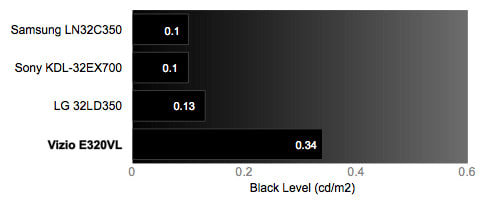
Peak Brightness
{{section_header}}{{section.name}}{{/section_header}}
The Toshiba 46XV648U can produce a wholly sufficient peak brightness score, meaning you'll have little cause to complain about how bright the whites get. The Samsung LN46B750 outscored the Toshiba in this test, but side-by-side, you probably wouldn't be disappointed with the Toshiba. More on how we test peak brightness.
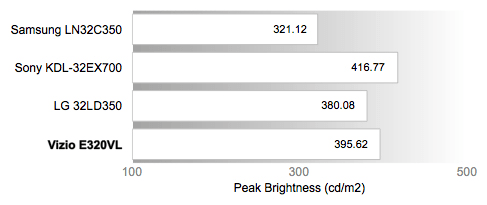
Contrast
{{section_header}}{{section.name}}{{/section_header}}
The contrast ratio scores here measure the actual black level-to-peak brightness range that the screen can produce in real life, without playing with the contrast, brightness, and other settings. Frequently, those overinflated contrast ratios that manufacturers tout is a result of tweaking the menu settings, taking a measurement, tweaking some more, taking another measurement, and so forth.
The Toshiba 46XV648U performed well here, thanks to a decent black level performance and a good peak brightness. The Samsung LN46B750 followed close behind. The Sharp and the other Toshiba (a 2009 model) did less well. More on how we test contrast.

Tunnel Contrast
{{section_header}}{{section.name}}{{/section_header}}
The Toshiba 46XV648U showed less than perfect results in the tunnel contrast test, which measures how well a TV can maintain black level as the amount of black on the screen increases and decreases. Ideally, it shouldn't matter, but the Toshiba showed a tendency to wander, for lack of a better term, with a trend towards getting brighter if the black patch was surrounded by bright white. More on how we test tunnel contrast.
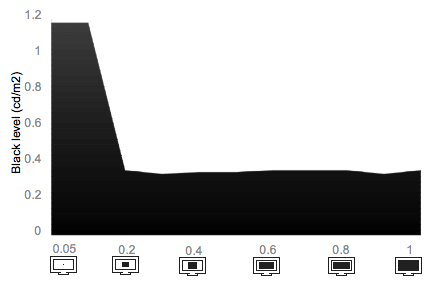
White Falloff
{{section_header}}{{section.name}}{{/section_header}}
Toshiba 46XV648U showed no problem, however, with maintaining peak brightness levels, as evinced by our White Falloff test. Most TVs do not have a problem here either. More on how we test white falloff.
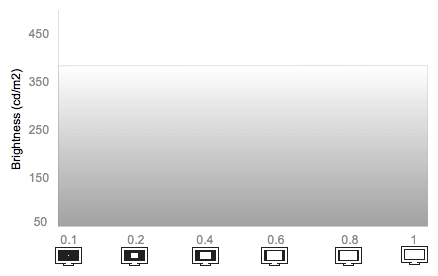
Uniformity
Greyscale Gamma
{{section_header}}{{section.name}}{{/section_header}}
The Toshiba 46XV648U showed a very good performance in the greyscale gamma test. The chart below shows how smoothly the TV can transition from shadows to highlights. Any bumps indicate areas where you would likely see some banding. Areas of of the line that are too horizontal indicate where the TV might be missing some detail. Those small, flatter segments in the lower-left side indicate some missing shadow detail. But overall, the performance was strong. The slope of the curve, 2.3, is nearly perfect. More on how we test greyscale gamma.
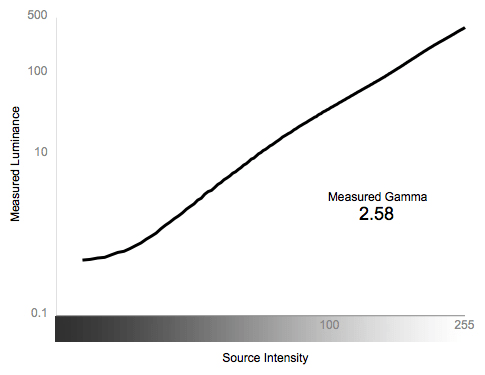
Color Temperature
{{section_header}}{{section.name}}{{/section_header}}
The Toshiba 46XV648U showed an excellent color temperature consistency in our lab tests. You can see from the charts below that the error rarely strayed into the range of human perception. Only when the signal got very dark did the color temperature get a little warm. More on how we test color temperature.

RGB Curves
{{section_header}}{{section.name}}{{/section_header}}
The Toshiba 46XV648U had a relatively good color curve performance, though it was not without its hiccups. In the chart below, you can see the results from testing every intensity level in the red, green, and blue channels. The ideal performance is a smooth, sloping curve. Bumps indicate areas where you can expect color banding to occur where there should otherwise be a smooth transition. That big bump in the blue channel is unusual. We could see the error pretty clearly if we displayed a band of blue across the screen. All we can say is we hope you don't see this particular color too often when you're watching TV. More on how we test RGB curves.

The color strips below are digital recreations of the three lines in the chart above. It's all 255 increments that make up each channel. Note how none of the TVs manage to get the shadow detail of the Ideal Response.
Motion Performance
{{section_header}}{{section.name}}{{/section_header}}
Motion Smoothness (8.13)
The Toshiba 46XV648U did very well in our motion performance tests, living up to its moniker of 'Cinema Series.' In order to bring out the best performance, we experimented with the Toshiba's special motion processing features: ClearFrame and Film Stabilization.
In our testing, we found that the ClearFrame feature had a significant impact on the TV's ability to maintain fine detail in moving objects. The difference between leaving ClearFrame on and off was obvious. But in certain circumstances, turning on the ClearFrame feature seemed to create some strobing artifacts.
Overall, the performance was better with 1080p video than with 1080i. High-frequency, high-contrast patterns like black & white stripes gave the Toshiba 46XV648U its biggest problems in 1080i.
Motion Artifacting (6.75)
There were definite instances of motion artifacting in both 1080p and 1080i footage. The strobing, mentioned above, would occur more often with the ClearFrame feature off. But when ClearFrame is turned on, strobing would occur in completely different areas of the screen, likely a result of converging correction processes failing.Nevertheless, the Toshiba 46XV648U is a strong performer in motion performance, overall, but you do need to play with the special features to get the best picture, and those settings may have to change depending on the content. More on how we test motion performance.
3:2 Pulldown & 24fps
{{section_header}}{{section.name}}{{/section_header}}
The Toshiba 46XV648U can manage 3:2 pulldown from native 24p content, but in the video looks very choppy when it pans horizontally. In order to correct the problem, the TV has a feature called Film Stabilization. There are a few settings for this feature, and only the strongest setting managed to smooth out the 24p footage. But this setting may have an effect on the quality of the picture that you don't like. It's strictly aesthetic and entirely up to the user. More on how we test 3:2 pulldown and 24fps.
Resolution Scaling
{{section_header}}{{section.name}}{{/section_header}}
The Toshiba 46XV648U is a native 1080p television, but a lot of the content you watch will likely be of a lower resolution. It's up to the TV's processor to upscale that footage so it fits on the screen. Fortunately, the Toshiba 46XV648U is very, very good at this task – better than more expensive TV's we've seen. Details are below for each resolution we test. More on how we test resolution scaling.
480p
This is the lowest resolution you're likely to see. The Toshiba 46XV648U lost no screen area to overscan, though we did see a lot of Moire patterns in high frequency areas.
720p
Footage in the 720p format also lost no screen area to overscan, and managed to stave off most problems associated with upscaling.
1080i
The 1080i footage looked nearly as good as native 1080p, with only the slightest Moire patterns in high frequency area.
Formats
{{section_header}}{{section.name}}{{/section_header}}
The Toshiba 46XV648U is a native 1080p television. It can, of course, display all other NTSC formats with no problem.
Viewing Angle
{{section_header}}{{section.name}}{{/section_header}}
The Toshiba 46XV648U has a mediocre viewing angle, a common ailment of LCD displays. It lost a significant portion of its contrast ratio at approximately 48 degrees (or 24 degrees from center on either side). This is a little lower than average, even for an LCD, but only by a few degrees.

Reflectance
{{section_header}}{{section.name}}{{/section_header}}
The Toshiba 46XV648U is pretty good at avoiding annoying glare from lights in the room. If a light is facing the screen dead-on (hopefully, a rare occurrence) it results in a huge star burst pattern. But as soon as the angle changes, the pattern disappears and the screen does a good job of deflecting light.
Video Processing
{{section_header}}{{section.name}}{{/section_header}}
The Toshiba 46XV648U has a handful or processing features that you, the user, can turn on and off at will. We recommend that you read our impressions, then experiment on your own. Settings can and should be modified depending on the type of content you're watching.
Calibration
{{section_header}}{{section.name}}{{/section_header}}
The Toshiba 46XV648U performs most accurately in Movie mode. The rest of our adjustments are below.

All of our calibration is done in conjunction with the DisplayMate software.
](http://www.displaymate.com/)
Video Modes
{{section_header}}{{section.name}}{{/section_header}}
The Toshiba 46XV648U has a fairly robust selection of video modes, which serve as a sort-of one-stop-shopping calibration if you don't have the patience or knowledge for a more accurate calibration.
Ergonomics & Durability
{{section_header}}{{section.name}}{{/section_header}}
The remote control that comes with the Toshiba 46XV648U is decent: completely functional and unremarkable. It feels comfortable in the hand, and most of the buttons are at least easy to reach.
Button Layout & Use
{{section_header}}{{section.name}}{{/section_header}}
The core functionality is divided into menu functions, with the numeric buttons, volume up/down & channel up/down at the top, menu controls in the middle, and play/stop/rewind/ff controls at the bottom. The menu controls, those in the middle, could certainly have been designed better. Normally, you need easy access to a 'Back' or 'Return' button when navigating a menu. On this remote, you need to use the 'Ch Rtn' button, which is located all the way up in the upper-right corner relative to the d-pad. As a result, it's hard to perform no-look operations without climbing up a steep learning curve.
Programming & Flexibility
{{section_header}}{{section.name}}{{/section_header}}
The remote that comes with the Toshiba 46XV648U (product number CT-90302, to be specific) can be programed to work with several other types of home theater devices, including non-Toshiba brands. The complete coding instructions are in the manual.
Connectivity
{{section_header}}{{section.name}}{{/section_header}}
Input Ports (7.5)
The Toshiba 46XV648U does not abound with ports for a model in the so-called 'Toshiba Cinema series,' but it certainly has all the basics covered. There are only three HDMI ports (normally you'd find four on comparable models), no internet connectivity, and no DLNA support.

Output Ports (2.0)
The Toshiba 46XV648U has one analog audio output and one digital audio output, standard for most HDTVs.
Other Connections (0.0)
The Toshiba 46XV648U has no other connections, except the USB described below.
Media (1.0)
There is a USB port on the side of the Toshiba 46XV648U, used for viewing photos loaded on thumb drives. The software is certainly on the skimpy side, as it could only read about half the JPEGs we tried, and none of the GIFs.
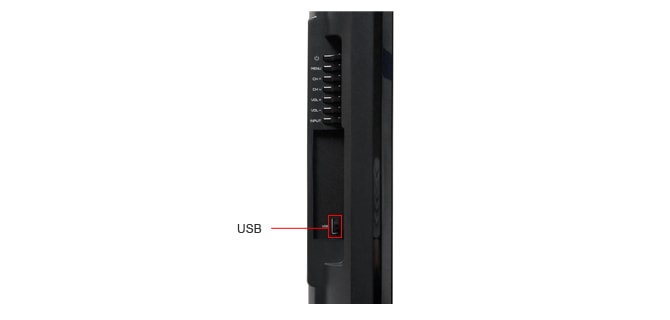
See the table below for the full breakdown.
{{product.manufacturer_specs['Connectivity Tour Image 3']}}
Placement
{{section_header}}{{section.name}}{{/section_header}}
The port placement on the Toshiba 46XV648U is decent, but the lack of a swivel base makes the rear ports difficult to access if you need to get to them frequently. At least there's one HDMI port and one composite AV port on the side for quick-changes.
Audio Quality
{{section_header}}{{section.name}}{{/section_header}}
The audio performance of the Toshiba 46XV648U is on par with its peers – that is to say, not very good. There are a few processing features that allow for tweaks in the performance, but the simple fact is that two little speakers in a TV cabinet can never match the cinematic experience that you're trying to emulate with a high-end television. For that, you need a separate audio system.
In the menu, you'll find options called Stereo Extension, Voice Enhancement, and Dynamic Bass Boost. The first setting had only a minimal impact on sound quality, which indicates that the surround sound-faking is not very good. The Voice Enhancement feature works quite well in drawing out dialog. The Dynamic Bass Boost brings up the bass in the mix, but it certainly doesn't sound good. In effect, it seems to increase the garbled rumble in the background. In no way does it sound like a subwoofer.
Menu Interface
{{section_header}}{{section.name}}{{/section_header}}
The menu interface on the Toshiba 46XV648U is pretty simple, even for neophytes. There are few deep menus in which to get lost, at least until you get into the ColorMaster settings (and at that point, you're probably a tech enthusiast who's less likely to get lost in any menu).
As we've stated before, the biggest frustration is finding the Return button on the remote, which is too far from the related buttons. It's easy to reach the 'Exit' button, but most of the time you don't want to leave the menu entirely, just go back a step.

Instruction Manual
{{section_header}}{{section.name}}{{/section_header}}
The instruction manual that comes with the Toshiba 46XV648U is rather good. Some kindly soul took the time to write up decent explanations of most features. Most importantly, there's alphabetical index in the back. You can find the Toshiba 46XV648U's manual online here.

A manual for so many TV models, they have to be further categorized by type.
Internet Features
{{section_header}}{{section.name}}{{/section_header}}
The Toshiba 46XV648U does not offer internet connectivity. This is perhaps unusual, but not unheard of, for a TV in this price range (based on the original $1799 MSRP, at least).
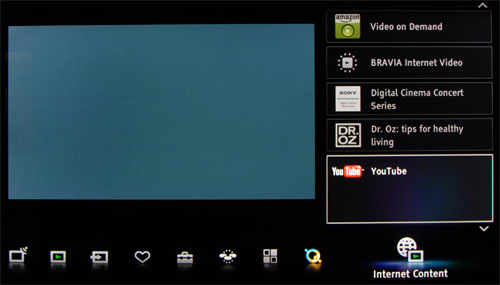
Local Media Playback
{{section_header}}{{section.name}}{{/section_header}}
Photo Playback (2.0)
Photo playback on the Toshiba 46XV648U is done using the USB port and a thumb drive. The interface is dead simple, and not very robust at all. The only feature is the ability to run the photos in a slideshow or leave the photos static. Perhaps the firmware isn't completely in place, because we couldn't get the TV to recognize about half of the JPEGs on our drive. It also couldn't read GIFs, though this is a more common problem with TVs. Overall, it's a weak implementation the feature.
Music & Video Playback (0.0)
The Toshiba 46XV648U does not play back video clips or music through the USB port, which is a big disappointment from a TV this expensive.
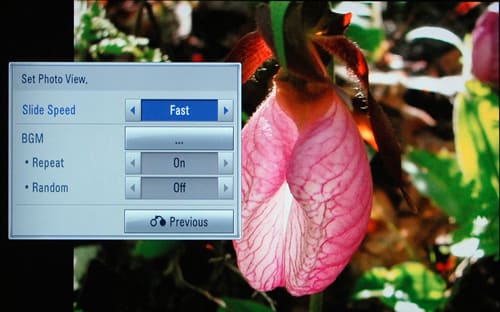
Other Media
{{section_header}}{{section.name}}{{/section_header}}
There are no other media features.
Power Consumption
{{section_header}}{{section.name}}{{/section_header}}
The Toshiba 46XV648U is surprisingly expensive to run. While most 2010 TVs have made strides to reduce power consumption, the 46XV648U is actually a few cents more expensive than a similarly sized Toshiba from last year. You can reduce the power drain by playing with the backlight controls, but setting it below our 'power saver recommendation' of 53 may detract from picture quality.
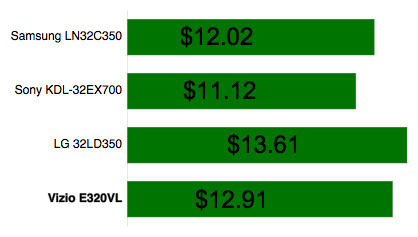
Value Comparison
{{section_header}}{{section.name}}{{/section_header}}
The Toshiba outperformed the Sharp LC-40LE700UN in most tests, and it's cheaper than the Sharp (depending on the retailed). With those facts in hand, the Toshiba seems like the stronger contender. For it's part, the Sharp had internet streaming content and photo/video/music playback. Of course, the streaming content on this particular Sharp is terrible.
Blacks & Whites
{{section_header}}{{section.name}}{{/section_header}}
The Toshiba 46XV648U had a much lower black level as well as a significantly brighter peak white. As a result, the contrast ratio is nearly twice as wide as the Sharp LC-40LE700UN.

Color Accuracy
{{section_header}}{{section.name}}{{/section_header}}
The color performance of both the Toshiba and the Sharp was very good, and the scores are close enough to consider being tied. You won't be disappointed with either.
Motion
{{section_header}}{{section.name}}{{/section_header}}
The motion performance of the Toshiba 46XV648U was distinctly better than the Sharp LC-40LE700UN, thanks in large part to the Toshiba ClearFrame feature, which helped maintain fine detail in objects in motion. Sure, there were still some instances of artifacting, but we really liked what we saw in the Toshiba.
Viewing Effects
{{section_header}}{{section.name}}{{/section_header}}
The viewing angle is one of the few areas of core performance where the Sharp outperformed the Toshiba. The Sharp had a viewing angle of roughly 55 degrees, while the Toshiba clocked in at 48 degrees.
Connectivity
{{section_header}}{{section.name}}{{/section_header}}
The Sharp undoubtedly has a better array of ports than the Toshiba, including an additional HDMI, an ethernet port for streaming content, and an infrequently used but nevertheless present RS-232C port.
Value Comparison
{{section_header}}{{section.name}}{{/section_header}}
The Toshiba 46RV525R is a 2009 model, and the Toshiba 46XV648U is a newer, 2010 model. However, the year-over-year changes are not revolutionary. Some of the features and processing have changed, and we noted an improvement motion performance. The new model also has a deeper black levels. But chances are, you'll be able to find last year's model more cheaply. All other factors, for the most part, are equal.
Blacks & Whites
{{section_header}}{{section.name}}{{/section_header}}
The newer Toshiba 46XV648U had a better black level and a slightly better peak brightness, which meant a wider contrast ratio overall.

Color Accuracy
{{section_header}}{{section.name}}{{/section_header}}
The color performances of both Toshibas was fairly similar, and both scores were very good.
Motion
{{section_header}}{{section.name}}{{/section_header}}
The motion performance of the newer 46XV648U appeared to do better than last year's 46RV525R, due in large part to the revamped ClearFrame motion processing feature. Last year, the feature was called ClearScan 240, and seemed to have less of an impact on the appearance of objects in motion.
Viewing Effects
{{section_header}}{{section.name}}{{/section_header}}
The viewing angle was about the same on both Toshibas, and neither was particularly good. If you need a wider viewing angle, you should probably check out plasma displays.
Connectivity
{{section_header}}{{section.name}}{{/section_header}}
The Toshibas both have three HDMIs and a handful of legacy ports for older types of devices. The new Toshiba has a USB port, but it makes poor use of it.
Value Comparison
{{section_header}}{{section.name}}{{/section_header}}
The Samsung LN46B750 was a strong performer, in most regards, though you certainly paid for it at the time. In the interim since its 2009 release, the price has dropped considerably. However, the newer Toshiba 46XV648U has already experienced a significant price drop. Overall, we'd pick the Toshiba for performance, but the Samsung for aesthetics and user experience.
Blacks & Whites
{{section_header}}{{section.name}}{{/section_header}}
The Samsung's black level was not nearly as good as the Toshiba, but the peak brightness was strong enough to push the contrast ratio up to match the Toshiba's.

Color Accuracy
{{section_header}}{{section.name}}{{/section_header}}
The color performance from both TVs was strong, as it is (thankfully) with most of the TVs we review. Both had the ability to maintain a strong color temperature and smooth RGB color curves.
Motion
{{section_header}}{{section.name}}{{/section_header}}
The Samsung LN46B750 managed to stand up to the strong motion performance of the Toshiba 46XV648U. Both showed excellent motion processing. However, the motion smoothing features on the Samsung may have had a more deleterious effect on the overall picture quality.
Viewing Effects
{{section_header}}{{section.name}}{{/section_header}}
The viewing angle on the Samsung LN46B750 was a little wider than the Toshiba 46XV648U, but the Samsung appeared to maintain slightly better color performance when viewed from an angle.
Connectivity
{{section_header}}{{section.name}}{{/section_header}}
The Samsung has one additional HDMI, ethernet streaming content connectivity (with very poor offerings), two USB ports, and EX-LINK.
Conclusion
The Toshiba 46XV648U yielded excellent performance scores in nearly every lab test, sending it to the front of the class. Home theater enthusiasts will also love the broad level of access that Toshiba allows to its finer PQ controls.
That said, the 46XV648U lacks in some of the flashier features that we've come to expect from higher-end TVs. There's no internet connectivity. The USB only supports photo playback, and it does that poorly. The design isn't ugly, per se, but it's hardly laudable. No, it seems this was a project straight from the Toshiba engineer's office, skipping the marketing department altogether.
We're going to give the Toshiba 46XV648U a recommendation based on its performance, but we understand that some people will pass on this in favor of a prettier Samsung or Sony.
Model Series Comparison
{{section_header}}{{section.name}}{{/section_header}}
There are only three models in the XV648U series, and we expect the same strong performance from all of them.
Photo Gallery
{{photo_gallery "Front Tour Image", "Back Tour Image", "Sides Tour Image", "Stand Photo", "Controls Photo", "Remote Control Photo", "Connectivity Tour Image 1", "Connectivity Tour Image 2", "Connectivity Extra Photo", "Menu Main Photo", "Menu 2 Photo", "Internet Features 1 Photo", "Internet Features 2 Photo", "Internet Features 3 Photo", "Local Media Playback 1 Photo", "Local Media Playback 2 Photo"}}
Ratings & Specs
{{manufacturer_specs_table}}
Meet the tester
David Kender oversees content at Reviewed as the Editor in Chief. He served as managing editor and editor in chief of Reviewed's ancestor, CamcorderInfo.com, helping to grow the company from a tiny staff to one of the most influential online review resources. In his time at Reviewed, David has helped to launch over 100 product categories and written too many articles to count.
Checking our work.
Our team is here to help you buy the best stuff and love what you own. Our writers, editors, and experts obsess over the products we cover to make sure you're confident and satisfied. Have a different opinion about something we recommend? Email us and we'll compare notes.
Shoot us an email